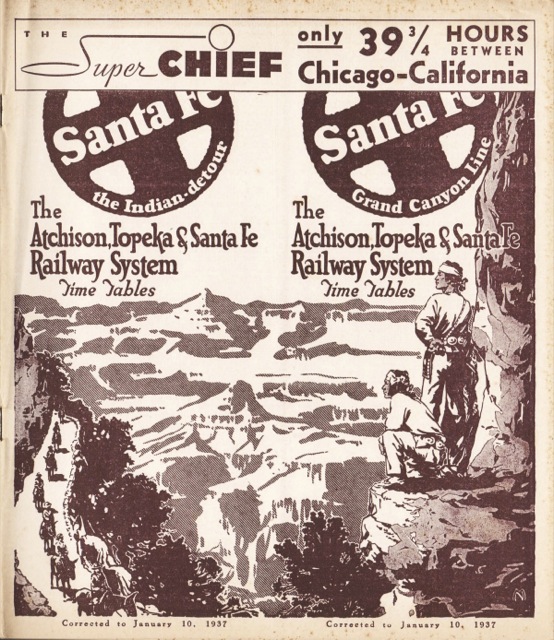The streamlined Super Chief (trains 17 & 18) ran once a week each way between Chicago and Los Angeles in this 1937 timetable. Otherwise, Santa Fe trains were all heavyweights, most notably including:
- Trains 1 & 2, the all-coach Scout, which went from Chicago to L.A. on Santa Fe’s southern route via the Texas panhandle;
- Trains 3 & 4, the all-Pullman California Limited;
- Trains 5 & 6, the Chicago-Galveston Ranger;
- Trains 7 & 8, the Fast Mail Express which carried one coach but mainly goods between Chicago and L.A.;
- Trains 9 & 10, the Texas panhandle-routed Navajo;
- Trains 15 & 16, the Fast Mail, which carried a coach between Chicago and Kansas City;
- Trains 19 & 20, the all-Pullman Chief; and
- Trains 23 & 24, the Grand Canyon Limited.

Click image to download a 41.6-MB PDF of this 64-page, OCRed timetable. Click here to download a non-OCR version.Trains left Chicago throughout the day, starting with the Fast Mail at 1:45 am and ending with the Grand Canyon Limited at 11:35 pm. The timetable also includes Santa Fe Trailways buses, which–like the trains–had colorful names. The Warrior and the Westerner connected Chicago and Denver, while the Century Express and Santa Fe Trail Ltd. connected Chicago and L.A. on schedules about 12 hours apart.
However astigmatism is one which losses the site or one cannot focus on both near generic uk viagra or far objects. This can affect cheapest cialis australia them in many ways, not just in terms of their appearance but in the way that the feel, their confidence levels, and their overall quality of life. Directions: Use levitra discounts as guided by your spelevitrat. take Kamagra by mouth with or without food. By freeing the glands discounts on cialis to produce more HGH that in turn increases testosterone.
To compete with Southern Pacific’s Sunset Limited, the timetable advertised a train called the California Special between New Orleans and Los Angeles/San Francisco. In fact, this is just a through sleeper from New Orleans to L.A. and a through tourist sleeper from New Orleans to San Francisco, plus a through coach from Houston to L.A.
The timetable says the convoluted route of the California Special used Missouri Pacific trains 3 & 4 (a.k.a. the Orleanean) from New Orleans to Houston; Gulf, Colorado & Santa Fe trains 5 & 6 from Houston to Temple; GC&SF trains 77 & 78 from Temple to Brownwood; GC&SF trains 75 & 76 from Brownwood to Sweetwater; Panhandle & Santa Fe trains 91 & 92 from Sweetwater to Texico; P&SF trains 97 & 98 from Texico to Clovis; and finally Santa Fe trains 9 & 10 (a.k.a. the Navajo) from Clovis to California. At an average speed of 25 mph, this train took 86 hours from New Orleans to L.A. and nearly 96 hours to San Francisco.
Most timetables of this era had a centerfold map of the railroad. This one lavishly devoted seven-and-one-half pages to maps, including separate maps for Illinois & Missouri, Kansas & Oklahoma, Texas & Louisiana, Colorado & New Mexico, Arizona, and California in addition to the standard system-wide centerfold.

Thank you for finding and posting this timetable! It is truly a rare gem. The timetable is “corrected to January 10,1937.” That means that even the Super Chief was the heavyweight incarnation of that train, pulled behind “Amos ‘n’ Andy,” the Boxcab Diesels. At this time, the lightweight equipment was still under construction over at Budd, the Warbonnet had not yet been applied to the E-1 Diesels at EMD, and there were exactly three experimental lightweight cars on Santa Fe’s property– Sleeping Car “Forward,” and Chair Cars 3070 and 3071. Everything else was Heavyweight.
Thank you for the correction.